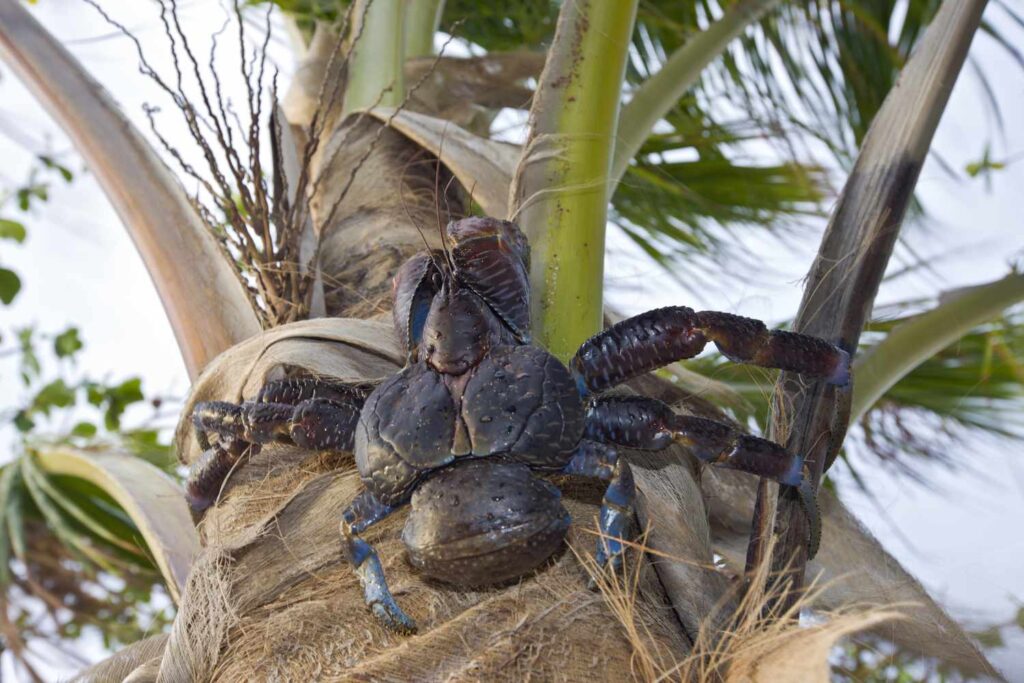
In the fascinating realm of nature, we often encounter extraordinary creatures that captivate our imagination. Among these remarkable beings is the Coconut Crab, a majestic and enigmatic arthropod that dwells on tropical islands. With its imposing size and unique behaviors, the Coconut Crab has earned a reputation as a true wonder of the natural world. Join us as we delve into the awe-inspiring facts and captivating behaviors of this extraordinary species.
1. A Giant of the Crustacean World:
The Coconut Crab (Birgus latro) reigns as the largest land-dwelling arthropod on our planet. Its massive size can be truly astonishing, with some individuals reaching a weight of up to 9 kilograms (20 pounds) and boasting a leg span of over 1 meter (3 feet). These colossal creatures are native to the Indo-Pacific region and can be found on various islands, including parts of the Indian Ocean and the Pacific Ocean.
2. Remarkable Adaptations:
Coconut Crabs have developed a range of adaptations that enable them to thrive in their unique habitat. Their exoskeletons are particularly robust, providing exceptional protection against predators and offering support for their large bodies. Moreover, their strong pincers, resembling those of a crab, allow them to climb trees and crack open the tough husks of coconuts with astonishing ease.
3. Climbing Maestros:
One of the most incredible feats performed by Coconut Crabs is their ability to climb trees. Despite their hefty size, these arthropods have remarkable climbing skills, using their strong legs and pincers to scale the trunks of coconut palms. This behavior serves a dual purpose: to feast on the juicy meat inside the coconuts and to create safe havens for themselves within the tree canopy.
4. Unique Dietary Habits:
As their name suggests, Coconut Crabs possess a strong affinity for coconuts. They have developed an impressive array of adaptations to extract the nourishing content from these fruits. The crabs use their powerful pincers to rip open the coconut husks, revealing the tasty flesh and liquid inside. Additionally, they are known to scavenge for other food sources, including fallen fruits, nuts, and carrion, showcasing their opportunistic nature.
5. The Life Cycle:
Coconut Crabs undergo a fascinating life cycle that begins in the ocean. After hatching, the larvae go through several stages before transitioning into a terrestrial existence. As they mature, they venture to the shores and eventually migrate inland, where they spend the majority of their adult lives. The Coconut Crab’s lifespan can reach up to 60 years, allowing them to grow into the magnificent creatures we see today.
6. Impressive Strength:
These arthropods possess astonishing strength, capable of exerting a tremendous amount of force with their pincers. Their grip is so powerful that they can crack open not only coconuts but also the tough shells of other creatures like snails and crabs. This immense strength contributes to their dominance in their habitat, as few creatures dare to challenge them.
7. Mysterious Nocturnal Wanderers:
Coconut Crabs are predominantly nocturnal creatures, choosing to venture out under the cover of darkness. Their nighttime excursions take them across the forest floor, where they scavenge for food and explore their surroundings. The secretive nature of these journeys adds an air of mystery to these already captivating creatures.
8. Environmental Impact:
While Coconut Crabs play an essential role in maintaining the balance of their ecosystem, their feeding habits can sometimes have unintended consequences. The arthropods’ love for coconuts often leads them to uproot and damage young coconut.
9. Conservation Efforts:
Due to their unique ecological significance and charismatic nature, Coconut Crabs have garnered attention from conservationists and researchers alike. Efforts are being made to protect their habitats and regulate their harvest, as unsustainable practices can threaten their populations. Education and awareness campaigns are also being conducted to highlight the importance of preserving these remarkable creatures and the ecosystems they inhabit.
10. Cultural Significance:
In many regions where Coconut Crabs are found, they hold cultural and traditional significance. Local communities often incorporate the presence of these majestic arthropods into their folklore, songs, and artwork. They are celebrated for their strength, resilience, and the mystery they evoke. These cultural connections further highlight the deep-rooted fascination and reverence people have for the Coconut Crab.
11. Curiosity and Intrigue:
The Coconut Crab’s colossal size, impressive strength, and peculiar behaviors have sparked curiosity and intrigue among scientists and nature enthusiasts. Researchers continue to study these creatures to unravel their secrets and shed light on their evolutionary history. With every new discovery, the Coconut Crab continues to captivate our imagination and challenge our understanding of the natural world.
12. The Future of the Coconut Crab:
As our planet faces ongoing environmental challenges, the future of the Coconut Crab hangs in the balance. Climate change, habitat destruction, and unsustainable practices pose threats to their populations. It is imperative that we prioritize conservation efforts, support scientific research, and raise awareness about the importance of preserving these magnificent creatures for generations to come.
Conclusion:
The Coconut Crab stands as a testament to the wonders of nature, showcasing the remarkable adaptations and behaviors that have enabled it to thrive as the largest land arthropod on Earth. From their extraordinary climbing abilities to their immense strength and unique dietary habits, these captivating creatures continue to intrigue and inspire awe. As we navigate the complexities of conservation and environmental stewardship, let us not forget the Coconut Crab, a true icon of the natural world deserving of our admiration and protection.







